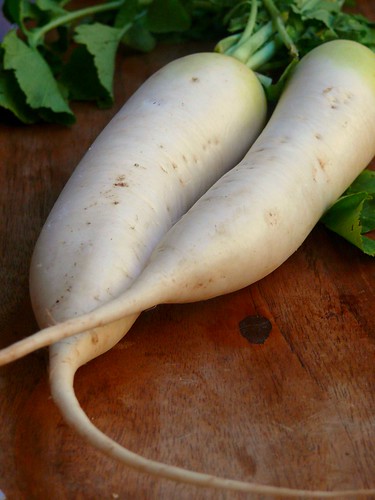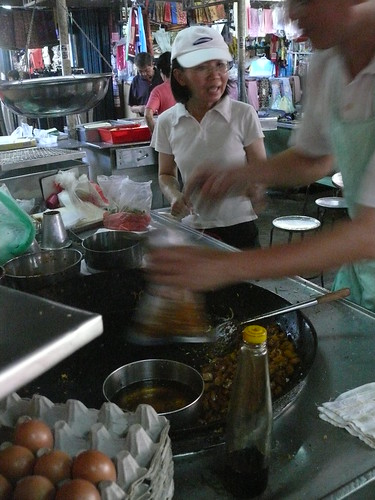WEEKEND HERB BLOGGING:
Daikon (from Japanese daikon 大根)Literally "large root" is a mild-flavored East Asian giant white radish. Though most widely known as daikon, the radish is also known under other names, including mooli in Hindi, Punjabi, nepali, bihari, daikon radish, Japanese or Chinese radish, winter radish, Korean or moo (Korean), moorro (Gujarati), moolah (Bengali), lobak, loh bak, lo-bok, or lor bak (Cantonese), labanos (Tagalog), rabu, phakkat-hua, and củ cải trắng[2] (Vietnamese).
It's breakfast time in Penang, Malaysia. My skin feels like tofu deep fried in the scorching sun.
Our new expat Aussie friend Kylie leads us off Burma Road down a side street and into a bustling tiled cafe crammed with Laminex tables. I'm puzzled. There seems to be no seats left here. Diners have their heads in bowls, eating with a seriously studied approach, but Kylie is striding purposely down to the back of the venue. We follow obediently, smiling at the staff and walking straight through the kitchen, out the back door and into the food hawker section of the Pulau Tikus wet market.
Immediately we are assaulted by robust spicy aromas, booming voices and the clang of cooking implements. We're in a large dark shed. Pools of light stream through holes in the iron roof onto the well worn concrete floor and plastic tables with low stools encircle an island of hawkers, each cooking just one specialty. As I adjust my vision to the gloom, I see that we have surfaced near the vendor of one of my favourite, peculiarly local Hokkien style dishes, Char Kway Kak - savoury fried daikon cake.
It's my lucky day. This is no ordinary Char Kway Kak stall, but Tan Choo Hoon's - a retiree in his 60's who four years ago took over the stall from the previous owner Ng Kim Siak who had begun the business in the 1970's. This famous Char Kway Kak has a big following and is a favourite of Malaysian dignitaries, state officials included.
As Kylie waved to another hawker for her standing daily order of soup noodles, I watched Mr Tan and his wife Lau Yeow Choo at work. Lithe and well practiced, the speed at which they belted the ingredients around in the enormous searing griddle plate manifested as a percussive blur of hands and steam. I watched the daikon cake being cut up roughly and fried; eggs and seasonings added in deftly. The smell made my mouth well with salivary anticipation and a cloud of chilli fired steam took my breath away - quite literally.
I sat down, the rest of our party were slurping on Koay Teow Th'ng and picking at crispy skinned roasted belly pork. When my plate of Char Kway Kak arrived, eyes widened like saucers. I felt smug. It was in short, delicious and unctuous. Slippery yet crunchy, savoury and filling with chilli tingling the sides and tip of my tongue, I could see why this simple version had loyal fans.

This is a dish which like many South East Asian meals juxtaposes contrasting textures to add another dimension to the pleasure of the flavours. Char fried cubes of steamed solid daikon paste are flavoured with garlic, palm oil or lard, chilli, dark soy sauce and garlic chives.
The balance of textures come from other ingredients - always there is egg and crisp bean shoots - but the optional extras that some people like to add include clams, Chinese Lup Cheong sausage, shrimp and even Chinese Cha Siu BBQ'd pork. Mr Tan's version comes without meat - perfect for breakfast - and I happily recreate it at home, where we eat it later in the day. My own version (photograph below) includes some chicken and Chinese sausage in the mix. I tend also to garnish it with fresh coriander (cilantro) and fried shallots.
 I am sharing this simple recipe with you as my first ever submission to Weekend Herb Blogging.
I am sharing this simple recipe with you as my first ever submission to Weekend Herb Blogging.For non blogging readers this is an event initiated by Kalyn's Kitchen for Bloggers around the world to share insight and recipes on unusual herbs or plant ingredients. It's been around for a couple of years and is a fascinating look at home cooking around the world.
The host of this particular event is Blogger Pam of Sidewalk Shoes, where the entries will be showcased after the closing date on July 6. For bloggers, it appears to be a great way to introduce new readers to your site and to find others of interest to you in the online food community.
Many people - Asians included are often at a loss as to how to cook the long white radish commonly known as Daikon, or in my Cantonese speaking family, Lor Bak. Often it is used incidentally as a mild textural filler or added late in cooking for contrast in a braise or clear soup while the vegetable's flavour is still sharp. You will also see it in Asian pickles and chutneys.

Most often I serve the daikon cake - in Cantonese, Lor Bak Goh - with some reconstituted dried shrimp in the mix, then sliced and pan fried crisp in yum cha style. I also like to use it fried in Fusion cooking as a bed for roast duck, served with crisp fresh lotus root and red cabbage with Pomegranate sauce.
If you can't be bothered or are in a hurry, you may even find the cake pre-made in Asian Grocers (see above). It is really quite simple to make with a bit of planning however. Choose fresh Daikon that are not bruised and avoid those with big cracks in them.
MY RECIPE
 Char Kway Kak
Char Kway KakHokkien style fried daikon cake
DEALBREAKERS:
1/ You may need to source some ingredients from Oriental Grocers.
2/ The daikon cake needs to be made at least 4hrs in advance.
FOR THE CAKE (MAKES 1KG):
175g rice flour
1 tbsp Tapioca flour
500ml water
1 tbsp cooking oil (I use canola or peanut oil Malays use palm oil traditionally)
2 cloves of garlic
175g peeled and shredded daikon
1 tsp salt
1 tsp white pepper
2 tsp sugar
In a large jug or bowl combine the two flours and water to form a smooth batter. Set aside.
In a pan or wok, saute the garlic in the oil until fragrant then add the daikon, fry until soft. Pour in the batter and season with the salt, pepper and sugar. Stir until the mixture is thick.
Remove from heat and pour mixture into a 23cm diameter greased tray, to a depth of roughly 4cm. Steam this for 30minutes over a wok of hot water or in a steamer. Once done leave to cool and set. This can take 4 to 6 hours, so is best to leave overnight in your fridge. Daikon cake keeps well refrigerated.
FOR THE FINAL DISH:
400g radish cake cut into 2cm cubes
1 large clove of garlic, smashed & minced
3tsp chopped preserved radish (optional)
2.5 tsp roasted chilli paste (Sambal Oelek) or to taste
2 tbsp light soy sauce
1 tbsp dark soy sauce
2 tsp Ketchup Manis
1 tbsp chicken stock OR a large pinch of powdered chicken stock (either optional)
2 large duck eggs (chicken is ok)
150g bean shoots
50g chopped garlic chives white pepper to taste
Heat and oil a large griddle or wok and fry the daikon cake over high heat until browned. Remove from wok. If adding in any seafood or meat do so at this stage, heat through and remove from pan. Repeat with garlic and preserved radish, when the aromas lift, add in chilli paste to warm through.
Return the radish cake to the pan and add the seasonings and sauces. Turn quickly to coat the cake well, then push to one side.
Add the 2 eggs to the pan and stir to scramble over the heat until they begin to solidify, then mix them back through the daikon cake. Return seafood or meat to the pan if using and then toss in the bean shoots and garlic chives. Heat through briefly and serve immediately.
Add the 2 eggs to the pan and stir to scramble over the heat until they begin to solidify, then mix them back through the daikon cake. Return seafood or meat to the pan if using and then toss in the bean shoots and garlic chives. Heat through briefly and serve immediately.



9 comments:
I remember this, though I haven't eaten it in a long time. Is it sort of rubbery? I love that you made the dish from scratch - will definitely have to try it some time.
Welcome to WHB, and what a great entry, so interesting. I haven't eaten anything quite like this, but I'm intrigued by it.
Y - it shouldn't be rubbery, more like soft melt in the mouth cubes of hor fun/kway teow. The daikon flavour is subtle because the sharp radish aspect is softened on cooking. My recipe is the same as Mr Tan's version though I'm sure others do it differently.
Thanks for the compliment Kalyn, I'm thrilled to have you read my post. I have been reading WHB posts for a while and thought I'd jump in with both feet - LOL! I like the new guidelines.
This recipe is not as low GI as my usual recipes, but that's why I add in some protein when cooking it for myself.
Congrats on the recipe Sticky,you have managed to make me feel hunger pangs toward a vege that I have been until now indifferent to.
Oh Gobbler, thank you - it is easy to be indifferent about the vegies whose flavour secrets lie shrouded in mystery. I think this has been part of my fascination for WHB events - though they haven't always been particularly informative. That's the reason why Kalyn has set up new event guidelines.
For me I feel the same way about the Rutabaga/Swede, but just one good recipe could change that. You don't see recipes for Daikon or swede in Cookbooks here and that most probably adds to the general indifference...so thanks for the thumbs up!
Great work SF. I also love swedes and daikon. Brasied daikon is so delicious.
I love turnip cake and will give this version a go.
Thanks for sharing this one. We get in a rut with our daikon, usually just putting it with pork-bone soup. This would be a new way of presenting the vegetable.
Thanks for stopping by Thermomixer - or is that ThermoMinx?? I have pantry envy after checking out your blog and enjoy your comments over at Gobbler's blog. Guess the turnip cake is ideal for a Thermo session?
Thanks also to EatingClub Vancouver. Shredded daikon would be a nice addition to your cucumber salad - don't you think? You could pickle them first in sugar, a pinch of salt and rice wine vinegar then toss them in for extra bite and crunch. I'm going to try your watermelon curry soon looks fab!
We are from Penang...me n my hub missing the Penang hawker food so much!! With your char keow kak recipe I made myself a great brekky with black coffee!! Thank you..!
Post a Comment